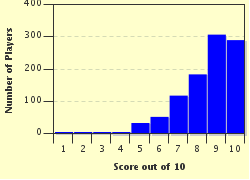Quiz Answer Key and Fun Facts
1. The original Broadway production of this stage musical, which made its debut in 1943, was performed 422 times. Written by the multi-gifted composer Cole Porter, and starring Ethel Merman, this show was particularly designed to show support for soldiers fighting overseas. Bearing in mind this focus, can you complete its title? "Something For the ... "
2. Perhaps because living with the fear of death every day during the 1940s was very real, people grasped at life with both hands as eagerly as they could. They flocked to the various entertainment centres to forget their cares with music, dance and song. Dancing was especially a big hit with couples during this time and quite a variety of dances existed. Just a few of these were the Big Apple and the Collegiate Shag and the Jitterbug. One in particular was very popular at the time. Named after a famous aviator, it was known as the Lindy ... (what)?
3. Movie going was also an important source of entertainment in the forties. By now studios were turning out more sophisticated films as opposed to the slapstick type of ones churned out earlier in the century, during which time a film a day could be shot. Talkies were also well and truly established by the forties. Many fine dramatic films were made during this period, but if one wanted a laugh, the series of Road movies made by Bing Crosby, Bob Hope and Dorothy Lamour were bound to bring about a chuckle or two. How many of these movies were made in all?
4. By 1939, there were 2,000 television sets in the United States. By 1941, commercial television began broadcasting. The war resulted in most television stations closing down, with only a few left to continue their work. After the war, television broadcasting began again in earnest, and from that time, it became king of the loungeroom in as many homes as possible where owners could afford a set. For those who did not possess a TV set, where did the vast number of these people manage to view television?
5. Big Band music was just about everywhere in the 1940s. Headed by men such as Artie Shaw, Benny Goodman, Harry James, Tommy Dorsey, Dizzy Gillespie, and Lawrence Welk, the list of big bands and their leaders is far too long to detail here. Accompanying many of these bands was a lead singer or singers to add to the entertainment, and songs could be heard being belted out, or crooned, in just about every popular entertainment venue of the time. A particularly popular song of the time, played by all bands, was "In the Mood". Which big band leader, whose plane disappeared over the English Channel on 15th December, 1944, made this song so very popular?
6. Cheerleading really began to forge ahead in the 1940s when women began to incorporate major gymnastics displays into their routines. Minor attempts at this new form of cheerleading had tentatively started in the 1920s but the routines were still very sedate, as became a lady. Is it true that the first cheerleaders were men?
7. This question has more of an Australian focus. Something we take completely for granted today was considered a rare form of entertainment back in the 1940s. Which of the choices listed below do you think that was?
8. Professional ballroom dancing, as opposed to your regular everyday dancing, began to grow very popular in the 1940s as a form of entertainment, and, by some, was even considered an artistic sport. A form of competitive ballroom dancing that was hotly contested then, and is still competed in today, is known by what name?
9. By the 1940s, radio was really beginning to make its mark as a form of entertainment on the world. Concerts, news, popular music, comedy and drama shows, sports events - all made their way into homes via the magic of that little box. The 1920s to the late 1950s became known as the "Golden Era of Radio", and this peaked in the forties when people were desperate to be distracted from the worries of the years leading up to the war and beyond. Many of the great film stars began their careers as performers in radio shows. These included Red Skelton, Jack Benny, Bob Hope, and a couple of comedians known as Abbott and...(who)?
10. This man started off his singing career during the era of swing, and went on to become one of the most successful solo singers during the first five years of the 1940s. Girls, known as "bobby soxers" screamed, fainted and wept hysterically during his shows if he even looked their way. Who was he?
Source: Author
Creedy
This quiz was reviewed by FunTrivia editor
kyleisalive before going online.
Any errors found in FunTrivia content are routinely corrected through our feedback system.

